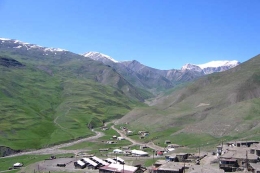Budukh is a Lezgic-Samur language that is spoken in the villages of Buduq, Guney Buduq and Geli Deya in Quban region of Azerbaijan. It is also spoken in a few other towns in Russia. By 2010, it was reported that the language had 200 speakers. The word Budukh is derived from the name of their largest settlement, Budad. Budukhs refer to their language as budad mez. Budukh is also referred to as Bukukhi, Budugi, Budux or Budug. The language has 2 dialects: Budukh and Yergyuch. The Budukh language is related to Kryz and Khinalug, which belongs to the Shahdag subgroup of the Dagestan, Caucasian languages. Shahdag languages are related due to their close geographical location, rather than as a result of there linguistic similarities. The language is mostly used domestically.
By the late 1980s, apart from a few people who spoke Azerbaijan, everyone in the Budukh community spoke the language fluently. Currently, 30-50% of Budukh children speak the language. People who moved away from the villages switched to speaking Azerbaijan. By 1994, only 30-35% of the Budukhs could speak the language. Most Budukhs are now bilingual as more of them find it necessary to learn Azerbaijan and Russian. Budukhs do not have a written language. They use Azerbaijan when it comes to writing. Azerbaijan is also the primary language of instruction in schools within the area. Budukh has never gained official status as a language in Russia. Studies into the language were initiated during the 20th century.
Physically, Budukhs are characterized by long narrow faces and thick hair. They are from the Balkano Caspian race. Most Budukhs are Sunni Muslims. Islam was introduced into the region by Arabs in the 8th century. Pagan beliefs and traditional customs are still central in the life of most Budukhs. The main economic activity practiced by Budukhs is animal husbandry. The houses are mainly made from whitewashed clay and straw, leading to the villages being nicknamed ‘The White City.’ The population of the Budukh varies widely from census to census. This can be attributed to seasonal migration, population shifts and the classification methods that are used in each census.
